This post may contain ads and affiliate links and we may earn a small commission when you click on the links at no additional cost to you. As an Amazon Affiliate, we earn from qualifying purchases. You can read our full disclaimer here.
Goldendoodle Behavior Stages All Owners Should Know and Love

Diving into the world of Goldendoodle behavior stages is like becoming a part-time detective – always intriguing, sometimes baffling, but ultimately rewarding.
Goldendoodles, those adorable bundles of joy that blend the best of Golden Retrievers and Poodles, are as much a surprise in behavior as they are in their cute looks. Understanding these furry enigmas is key, whether you’re in the puppy honeymoon phase or navigating the golden years.
In this blog post, we’ll take a whimsical yet informative stroll through the Goldendoodle behavior stages, from the ‘zoomies’ of 8-week-old puppies to the more dignified pace of their senior days.
Expect to explore the rollercoaster of energy levels, social shenanigans, training triumphs (and trials), and the evolution of playtime.
And because every tale is better with a personal twist, I’ll sprinkle in anecdotes from my own life with an 11-year-old Goldendoodle – a fluff ball of wisdom who’s been schooling me since his puppy days.
Goldendoodle Behavior Stages from 8 Weeks to One Year
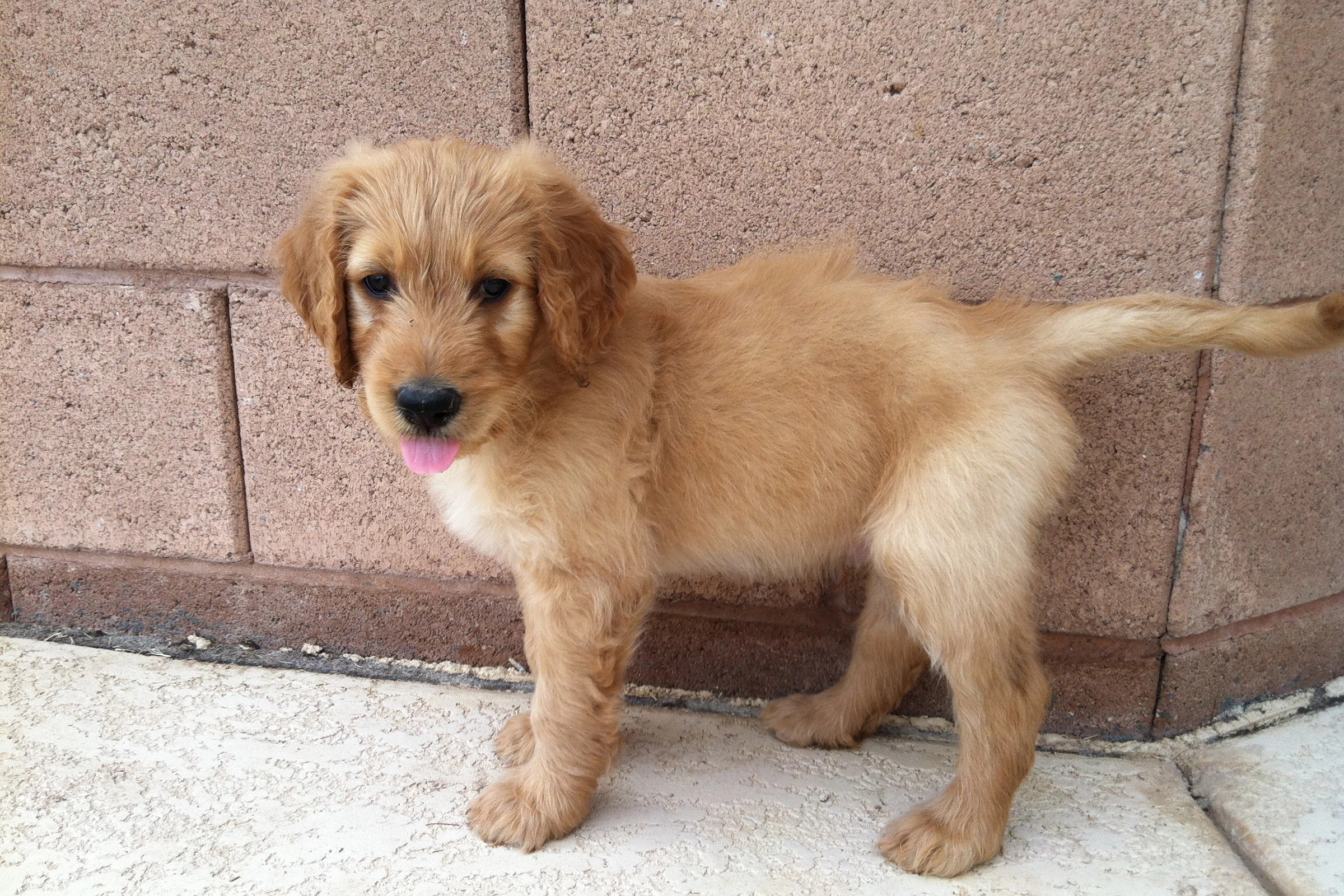
Adjusting to the New Environment in the Initial Days at Home
The arrival of an 8-week-old Goldendoodle puppy marks the beginning of a wonderful, albeit challenging, journey. These initial days are crucial for your puppy as they transition from the familiarity of their litter to the newness of your home.
Goldendoodle puppies, in their formative weeks to months of puppyhood, exhibit a fascinating array of behaviors as they grow and adapt to their surroundings.
Understanding these behaviors is crucial for any owner to ensure they develop into well-adjusted, happy adult dogs.
Curiosity and Exploration
At this age, Goldendoodle puppies are incredibly curious about their world. They often explore their environment with enthusiasm, sniffing around, investigating every corner, and sometimes even tasting things to learn about them.
This exploratory behavior is vital for their cognitive development but requires supervision to keep them safe.
Energetic and Playful Nature with Goldendoodle Behavior Stages
These puppies are known for their high energy levels. They often engage in bursts of play, followed by periods of rest. You’ll see them running around, playing with toys, and initiating games.
This playfulness is an essential part of their physical and social development, helping them learn boundaries and social cues.
Social Behaviors
Goldendoodle puppies are generally very social. They enjoy interacting with humans and other animals, showing a keen interest in making friends.
This trait makes them excellent family pets and companions but also means they need regular interaction and socialization to develop good social habits.
Read our post, Why Is My Goldendoodle so Clingy?
Learning and Responsiveness
Being a mix of two intelligent breeds, Goldendoodles are quick learners. They respond well to positive reinforcement training methods, making this the ideal time to start basic training.
You’ll notice their attentiveness and eagerness to please, which can be harnessed to teach them commands and good behaviors.
Teething and Chewing
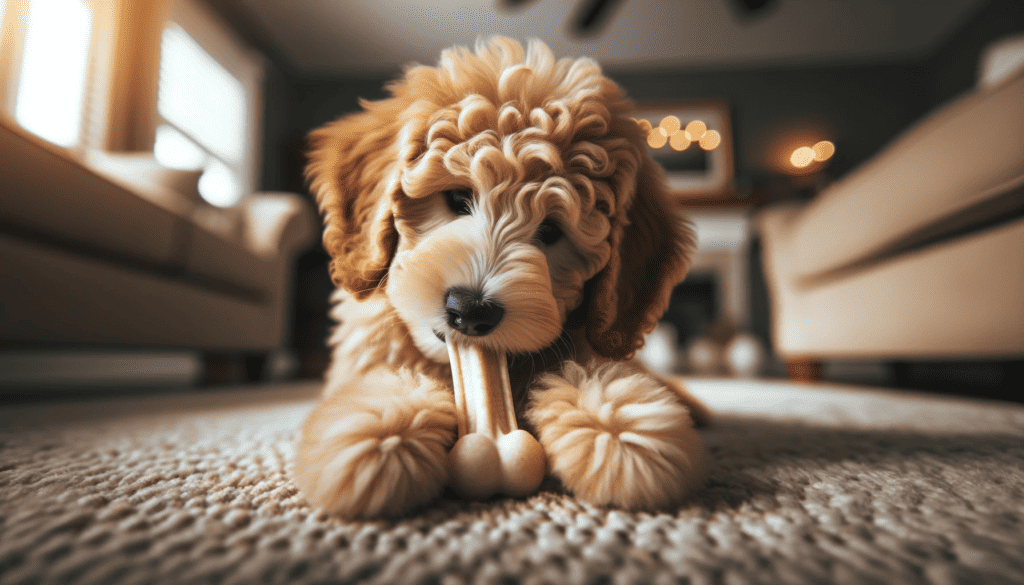
Like all puppies, Goldendoodles go through a teething phase, where they chew on things to relieve discomfort in their gums. This can sometimes lead to destructive chewing if not managed correctly.
Providing them with appropriate chew toys and monitoring them can help mitigate this behavior.
Testing Boundaries
Puppyhood is also a time when your Goldendoodle might test limits and boundaries as they learn about their environment and their place in the social hierarchy.
Consistent and gentle guidance is key to helping them understand and adhere to the rules of the household.
Sleep Patterns in Puppy Goldendoodle Behavior Stages

Goldendoodle puppies sleep a lot – up to 18 hours a day! This rest is crucial for their development. They often have a pattern of play, eat, and sleep, which helps in their growth and development.
Understanding and nurturing these behaviors in your Goldendoodle puppy will not only aid in their development but also strengthen the bond between you and your pet.
Remember, patience, consistency, and positive reinforcement are the keys to successfully navigating through this delightful, albeit sometimes challenging, stage of their life.
Early Socialization Tips for Goldendoodle Puppies
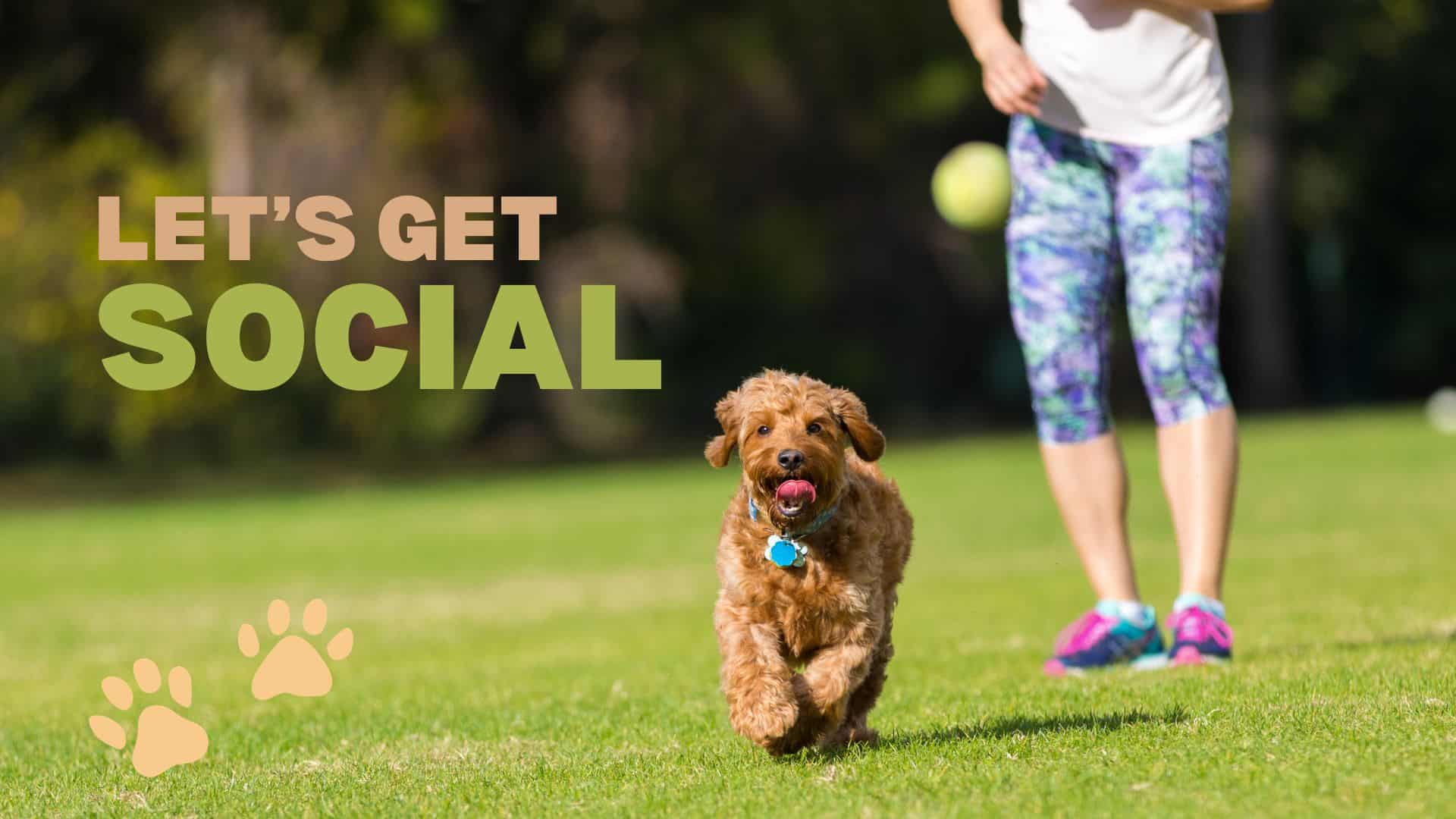
Socialization in the early weeks of a Goldendoodle’s life is about gently introducing them to a variety of experiences. This period is not just crucial for their behavioral development but also sets the stage for their future interactions with the world.
It’s about teaching them that the world is a friendly place, filled with all sorts of interesting and non-threatening experiences.
- Meet New People and Pets: Introduce your puppy to a variety of people and friendly pets.
- Explore New Environments: Take them to different places to experience new sights and sounds.
- Encourage Positive Interactions: Reward them for calm and curious behavior in new situations.
- Socialize Safely: Ensure all interactions are controlled and positive, especially with other animals.
Consult Your Vet: Before starting any socialization activities, have a discussion with your vet about your puppy’s vaccination needs and schedule.
Understanding and Managing Puppy Energy Levels and Playfulness
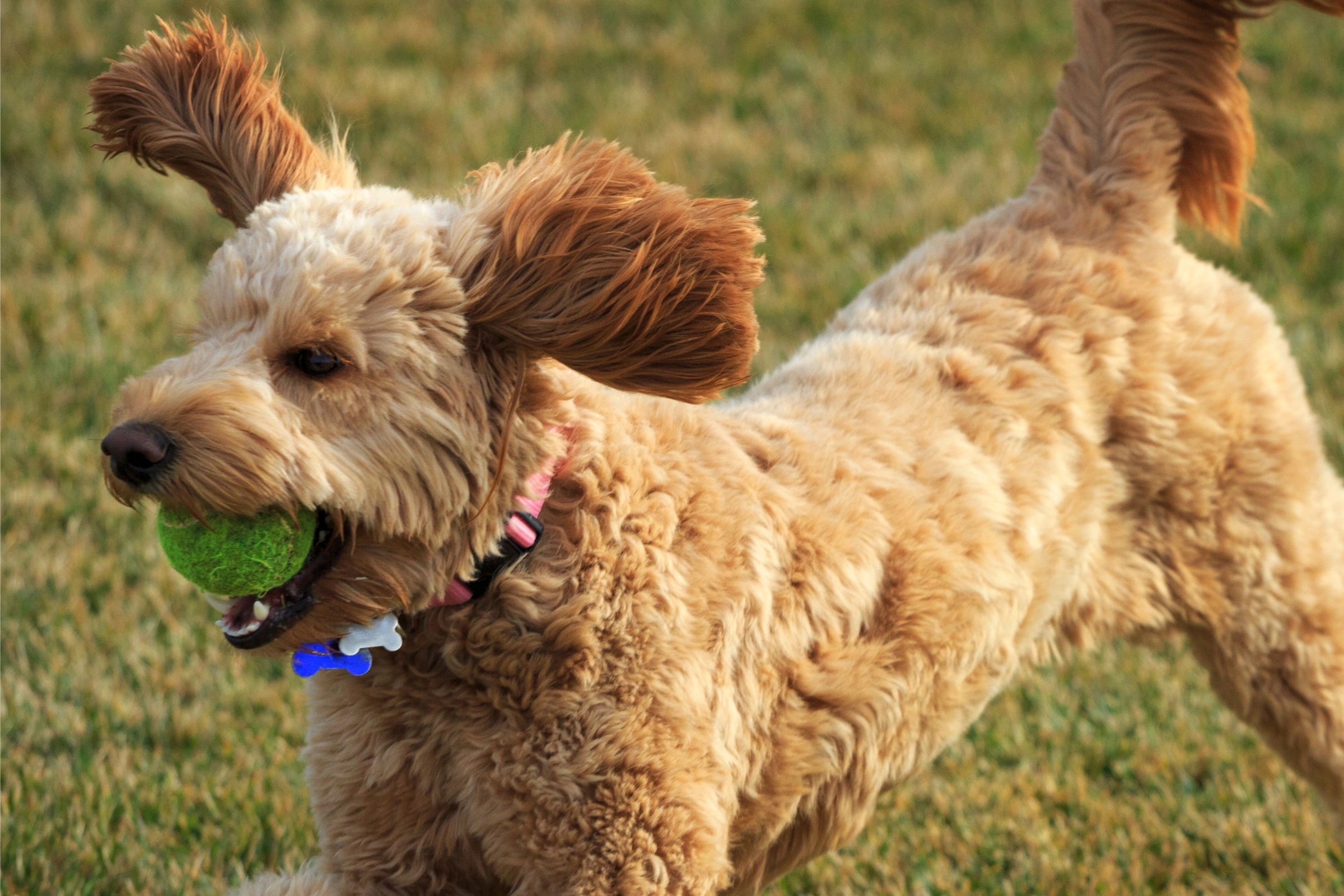
Goldendoodle puppies are a whirlwind of energy, often bouncing between playful antics and deep slumbers. Understanding and managing their energy levels is key to ensuring they grow into well-adjusted adults.
This stage is all about finding the right balance between play, training, rest, and socialization.
- Regular Playtime: Engage in regular play sessions to help them expend energy.
- Variety of Toys: Offer a range of toys, including chew toys, balls, and interactive puzzles.
- Structured Play: Incorporate basic training commands into playtime for mental stimulation.
- Monitor Play Intensity: Ensure play is gentle to protect their developing bodies.
Training and Responsiveness in Goldendoodle Puppies
Training a Goldendoodle puppy is an exercise in patience, consistency, and understanding. At this stage, their minds are incredibly receptive, making it an ideal time to lay the groundwork for basic obedience and house manners. The key is to make training a positive and rewarding experience.
- Simple Commands: Begin with basic commands like ‘sit’, ‘stay’, ‘come’, and ‘heel’.
- Positive Reinforcement: Use treats and praise to reward desired behaviors.
- Short Training Sessions: Keep training sessions short but frequent to maintain their attention.
- Consistent Rules: Ensure everyone in the household follows the same training and behavior guidelines.
Tackling Common Misbehaviors with Effective Solutions
Puppies, including Goldendoodles, are known for their adorable yet sometimes challenging behaviors like biting, chewing, and jumping.
It’s important to address these behaviors early on with patience and consistent training techniques.
- Redirect Chewing: Provide chew toys and redirect them from chewing inappropriate items.
- Gentle Bite Inhibition: Teach bite inhibition by giving a gentle yelp and stopping play if they bite too hard.
- Discourage Jumping: Ignore your puppy when they jump and reward them when all four paws are on the ground.
- Consistent Correction: Use a firm but gentle voice to correct misbehaviors and immediately redirect to appropriate behavior.
Wondering if you can have a mixed pet house? Read our post about Goldendoodles and cats.
Breakdown of Goldendoodle Behavior Stages in the First Year
8-12 Weeks: Initial Adjustments and Discoveries
- Home Adjustment: Newly adopted Goldendoodles might whine or seem anxious as they miss their littermates and mother. Comforting them and creating a warm, welcoming space is crucial.
- Curiosity Overload: They exhibit intense curiosity, sniffing and exploring every nook. They might try to nibble on furniture, shoes, or anything within reach, driven by curiosity and teething.
- Socialization Beginnings: They’re usually open and friendly but can be shy or nervous around new stimuli. Gradual introductions to different people, sounds, and gentle pets are beneficial.
- Puppy Playfulness: Their play involves lots of tumbling with siblings or toys, clumsy jumps, and adorable attempts at barking and growling.
3-6 Months: Rapid Growth and Learning
- Teething and Chewing: Expect increased chewing as they teethe. They may specifically target hard objects to soothe their gums.
- Social Skills Development: During interactions, they learn important social cues – they might play-bow to invite play or learn to interpret other dogs’ signals.
- Training Progress: They start understanding basic commands like ‘sit’ and ‘stay’. However, distractions can easily divert their attention.
- Sporadic Energy Levels: Play sessions become more vigorous and longer. They might spontaneously sprint around the house or yard, a behavior often termed the ‘zoomies’.

6-9 Months: The Adolescent Phase
- Boundary Testing: This is akin to human teenage behavior. They might deliberately disobey commands to test their independence.
- Continued Socialization: Interactions with other dogs become more sophisticated. Play might include more chasing and mock-fighting, learning to moderate bite strength.
- Growing in Size and Strength: Their physical growth is rapid, and they start to look more like their adult selves, though still retaining a puppy-like charm.
- Mental Challenges: They enjoy challenges and can start solving more complex puzzles. Their curiosity can lead them into mischief, like investigating counters or trash cans.
9-12 Months: Preparing for Adulthood
- Emerging Adult Behaviors: They start to exhibit more mature behaviors. While they’re still playful, there’s a noticeable shift towards a more adult demeanor.
- Advanced Training: They can grasp more complex commands and enjoy learning tricks that challenge them both mentally and physically.
- Personality Development: Individual personality traits become more pronounced – some may show a preference for certain types of play or interaction.
- Pre-Adult Testing: They may have a final phase of testing boundaries, requiring consistent reinforcement of rules and training.
In this first year, the Goldendoodle behavior stages are marked by significant physical, mental, and emotional development. Observing these changes closely and responding with appropriate training, socialization, and affection will help in shaping a well-rounded and joyful adult Goldendoodle.
Personal Anecdote: Puppy Days with My Goldendoodle

Reflecting on the puppy days with my Goldendoodle brings back a mix of fond and funny memories. One particularly amusing incident was his obsession with a squeaky toy. He would proudly parade it around the house, squeaking incessantly until he fell asleep with the toy still clutched in his jaws.
Raising a Goldendoodle puppy is a journey filled with learning, laughter, and love. By understanding and responding to their behaviors, you can ensure a smooth transition from puppyhood into a well-mannered adult dog.
Goldendoodle Behavior Stages During Adolescence and Early Adult Years (1-3 years)
Navigating Goldendoodle Behavior Stages in Adolescence
As your Goldendoodle enters adolescence, typically around the age of one, you’ll notice a shift in their behavior, often likened to the ‘teenage’ phase in humans.
This period can be marked by a mix of independence, stubbornness, and a retesting of boundaries, mirroring the challenges faced during human adolescence.
Fluctuating Energy Levels
Adolescent Goldendoodles may display variable energy levels. While they still possess a high level of energy, you might notice periods of restlessness followed by moments of lethargy.
This fluctuation is a normal part of their development as they transition from puppyhood to adulthood.
Responsiveness and Training Regression
During this phase, your Goldendoodle might show signs of training regression. Commands they previously mastered may now be met with a lack of responsiveness or selective hearing.
This behavior is not a sign of disobedience but rather a natural part of their developmental process where they re-evaluate and test their learned behaviors and boundaries.
Increased Independence
Adolescence is when Goldendoodles start to assert their independence more. They may seem less interested in seeking constant approval and might venture off on their own during walks or playtime.
Testing Boundaries with Goldendoodle Behavior Stages
Much like human teenagers, adolescent Goldendoodles may test the limits of what they can get away with. This can manifest in behaviors like ignoring recall commands, jumping on furniture they’re not allowed on, or other minor acts of defiance.

Advanced Training and Continued Socialization
This stage is crucial for reinforcing and building upon the basic training and socialization your Goldendoodle received as a puppy.
- Consistency in Training: Despite any regression, it’s important to maintain consistency in training. Revisiting basic commands and gradually introducing more complex tasks can reinforce learned behaviors.
- Socialization: Continued socialization is key. Exposing your Goldendoodle to different environments, people, and other animals helps them become well-adjusted adults. This ongoing socialization is critical in preventing fear or aggression issues later in life.
- Mental Stimulation: Advanced training exercises that challenge them mentally, like agility training or advanced obedience classes, can be beneficial. This not only reinforces good behavior but also provides much-needed mental stimulation.
- Positive Reinforcement: Keep using positive reinforcement methods. Reward good behavior with treats, praise, or play to reinforce that following commands is beneficial and enjoyable.
Addressing New Goldendoodle Behavior Stages and Challenges
Adolescence can bring about new challenges as your Goldendoodle tests their boundaries and learns about their place in the world.
- Dealing with Stubbornness: Sometimes, your Goldendoodle may seem stubborn. It’s important to distinguish between stubbornness and confusion. Ensure your commands are clear and consistent. Patience is key in dealing with these moments.
- Selective Listening: They may exhibit selective listening, especially in distracting environments. Practice commands in various settings to improve focus and responsiveness.
- Reinforcing Recall Commands: Recall commands can become challenging during this phase. Regular practice in safe, enclosed areas can help reinforce these commands.
- Professional Guidance: If certain behaviors become problematic or unmanageable, seeking advice from a professional dog trainer or behaviorist can be helpful.
Maintaining Play and Exercise with Goldendoodle Behavior Stages
As your Goldendoodle grows, adapting play and exercise routines to suit their changing needs is important.
- Adapting Play Activities: Their play preferences may change as they grow. Introduce new toys and games to keep them engaged and interested.
- Regular Exercise: Regular exercise remains crucial for their physical health and mental well-being. Activities like long walks, hikes, or swimming can be great ways to expend energy.
- Interactive Play: Engage in interactive play sessions that challenge them both physically and mentally. Games like hide-and-seek or fetch with a twist (like using different commands to retrieve different toys) can be beneficial.
- Balancing Rest and Activity: Be mindful of their need for rest. As they transition out of the high-energy puppy phase, they might require more downtime.
Navigating through the adolescent and early adult years of your Goldendoodle’s life can be challenging but equally rewarding.
Understanding and adapting to their changing behaviors, maintaining consistent training and socialization, and addressing new challenges with patience will help you raise a well-adjusted and happy adult Goldendoodle.
Goldendoodle Behavior Stages During Adult Years (4-7 years)

Maturing Behaviors: Understanding Shifts in Energy Levels and Social Preferences
As Goldendoodles transition into their adult years, typically between the ages of four and seven, their behavior often undergoes notable changes, reflecting their maturation.
This period marks a shift from the youthful exuberance of puppyhood to a more settled and predictable pattern of behavior.
Shifts in Energy Levels
While still energetic and playful, adult Goldendoodles generally exhibit a more regulated energy level. They may enjoy long, leisurely walks over the high-energy sprints of their younger years.
Their playtime, while still important, might become less frenetic and more structured.
Changes in Social Preferences
Adult Goldendoodles might show a change in their social behavior. While they remain friendly and sociable, they may become more selective about their canine friends and prefer familiar companions over new ones.
Their interactions with humans may also become more nuanced, showing deeper bonds and preferences.
Settled Routine
You may notice your Goldendoodle settling into a more predictable daily routine. They often become more consistent in their habits, from feeding times to their favorite resting spots.
Increased Confidence
Adult Goldendoodles typically exhibit increased confidence in both familiar and new environments. This confidence comes from their past experiences and the stability in their upbringing.
Continued Training and Mental Stimulation: Ensuring a Stimulated and Engaged Mind
Even as adult dogs, Goldendoodles benefit greatly from continued training and mental stimulation. This phase is crucial for maintaining their cognitive health and preventing boredom.
- Advanced Training Techniques: Building on the basic training of their earlier years, you can introduce more complex training techniques. This can include advanced obedience training, learning new tricks, or even participating in dog sports like agility or rally obedience.
- Mental Stimulation: Providing mental stimulation is as important as physical exercise. Puzzle toys, scent games, and interactive play sessions can keep their minds active and engaged.
- Consistency in Commands: Continuing to reinforce previously learned commands ensures that your Goldendoodle maintains good behavior and responsiveness.
- Training as a Bonding Activity: Training sessions are not just for learning; they’re also great opportunities for bonding with your Goldendoodle, strengthening your relationship.
Health and Behavior: Recognizing the Interplay Between Physical Wellbeing and Behavioral Changes
As Goldendoodles mature, their health starts to have a more pronounced impact on their behavior.
- Monitoring Health: Regular check-ups with the vet are important to monitor their overall health. Early detection of health issues like joint problems, obesity, or dental issues can prevent them from affecting your dog’s behavior and quality of life.
- Diet and Exercise: Maintaining a balanced diet and regular exercise routine is crucial for their physical health, which in turn influences their behavior. An overweight dog might be less inclined to play, while a dog in pain may become more irritable or withdrawn.
- Behavioral Indicators of Health Issues: Changes in behavior, like increased aggression, anxiety, or lethargy, can sometimes be indicators of underlying health issues. Paying close attention to such changes is essential.
- Stress and Anxiety Management: Understanding how to manage stress and anxiety in your Goldendoodle is important. Providing a stable environment, regular exercise, and mental stimulation can help in managing behavioral issues related to stress or anxiety.
The adult years of a Goldendoodle’s life are marked by a deeper understanding and stronger bond between the dog and its owner.
Recognizing and adapting to the changes in their behavior, maintaining their health, and providing continuous mental stimulation are key to ensuring a happy and fulfilling life for your beloved companion.
Goldendoodle Behavior Stages in Senior Years (8+ years)
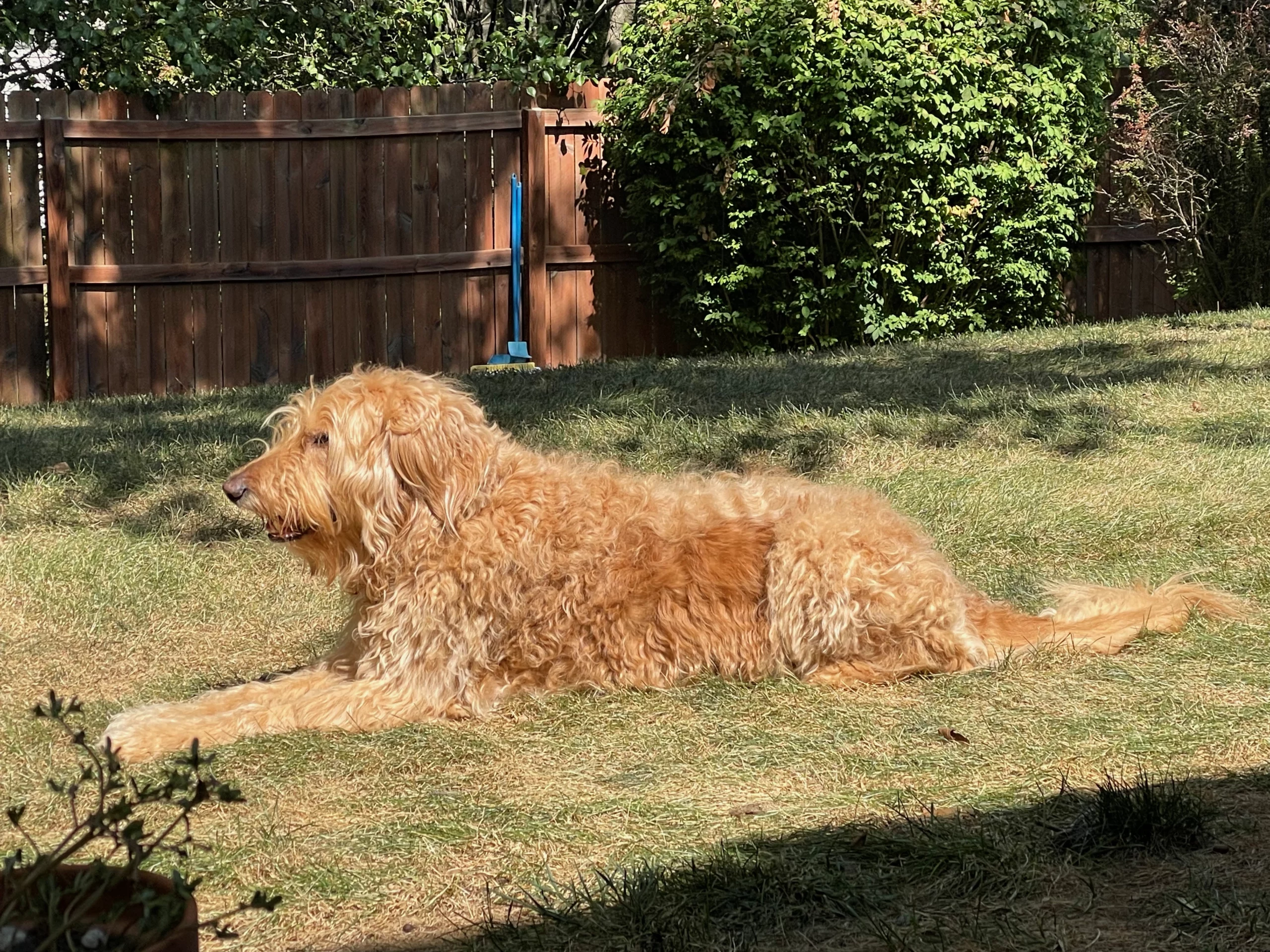
Understanding Senior Behavior: Navigating the Golden Years
The senior years of a Goldendoodle’s life, typically beginning around the age of eight, bring about distinct changes in their behavior.
These changes are part of the natural aging process and understanding them is key to providing the best care during this stage.
Reduced Energy and Activity Levels
One of the most noticeable Goldendoodle behavior stages in senior years is a decline in energy. Your once lively Goldendoodle may prefer tranquil activities, showing less interest in high-energy games.
It’s common for them to enjoy shorter walks and more time resting.
Altered Sleep Patterns
Senior Goldendoodles often sleep more than they did in their younger years. This increased need for rest is a natural aspect of aging, and it’s important to provide them with a comfortable, quiet space for their extended naps.
Want to learn more about sleeping? Read our post, Do Goldendoodles Like to Sleep with You?
Cognitive Changes for Senior Goldendoodle Behavior Stages
Cognitive decline, similar to dementia in humans, can occur. Signs include disorientation, confusion, or changes in behavior, such as increased vocalization or altered interactions with family members. Understanding and patience are vital as they navigate these challenges.
Sensory Impairments
Age may bring about diminished hearing and sight, impacting how your Goldendoodle interacts with their environment. They may become startled more easily or hesitant in unfamiliar settings.
Managing Energy Levels and Health: Tailoring Care for Senior Goldendoodles
The senior phase of Goldendoodle behavior stages requires adjustments in care to suit their changing needs, ensuring they remain comfortable and content.
- Adjusted Exercise Regimen: Tailor your Goldendoodle’s exercise to their aging body. Replace vigorous activities with gentle walks or light play that won’t strain their joints.
- Regular Health Check-Ups: Regular veterinary visits are crucial to monitor and address age-related health issues such as arthritis, heart health, or weight management. Proactive health care can greatly enhance their quality of life in their senior years.
- Dietary Considerations: Senior Goldendoodles may benefit from diets specifically formulated for older dogs. These diets can help maintain a healthy weight and support joint health.
- Comfort-First Approach: Ensure your home is comfortable for a senior dog. This might include orthopedic beds for joint support, ramps to access higher places, and maintaining a warm, cozy environment.
Personal Anecdote: Experiencing the Senior Goldendoodle Behavior Stages with My Dog
In the senior stage of my Goldendoodle’s life, I’ve witnessed a graceful transition from an energetic companion to a serene, mature friend.
His enthusiasm for long walks has been replaced with a preference for leisurely strolls and quiet moments together.
One touching change is his newfound fondness for soft, cozy spots around the house, often choosing to rest near us. This stage has deepened our bond and taught me the value of patience, understanding, and adapting to his evolving needs with love and care.
The senior years in the Goldendoodle behavior stages are a time of significant change, both physically and behaviorally.
Recognizing and adapting to these changes allows us to provide our aging companions with the love, care, and comfort they deserve, enriching their golden years with dignity and warmth.
BONUS SECTION: 17 Cute Behaviors in Goldendoodle Behavior Stages
Goldendoodles are known for their charming and lovable behaviors. Throughout their different life stages, these delightful dogs exhibit a range of endearing traits that can melt any dog lover’s heart.
Here’s a list of 17 cute behaviors commonly seen in Goldendoodles:
- Puppy Zoomies: Those sudden bursts of energy where they run around wildly, often in circles.
- The Classic Head Tilt: When they tilt their head in curiosity or confusion, especially when you talk to them.
- Fetching Frenzy: Their enthusiasm for fetching toys or balls, often accompanied by a wagging tail and excited barks.
- Play Bow: The adorable stance where they bow with their front legs stretched out and rear up, signaling playtime.
- Shadowing: Following you around the house, as if they’re your little fluffy shadow.
- ‘Puppy Dog’ Eyes: Mastering the art of the irresistible, soulful ‘puppy dog’ look, especially when they want a treat.
- Happy Dances: Showing their happiness with little dances or hops, particularly when you come home.
- Sitting on Feet: Sitting or lying on your feet, a way of staying close and showing their love.
- Nose Nudges: Gently nudging your hand or leg with their nose to get your attention.
- Hiding Toys: The cute habit of hiding their favorite toys in secret spots around the house.
- Sighs and Grumbles: Making little sighing or grumbling sounds when they settle down or are content.
- ‘Smiling’: Goldendoodles often look like they’re smiling, especially when they’re relaxed and happy.
- Tail-Chasing: The amusing behavior of chasing their own tail, often out of playfulness or sheer joy.
- Loving Gaze: Holding a long, loving gaze with their human, showing trust and affection.
- Fluffy Napping Positions: Sleeping in the funniest, fluffiest positions imaginable.
- Sneaky Sniffers: Using their keen sense of smell to sniff out treats or interesting scents.
- Paw Offers: Offering a paw, either as a learned behavior for treats or as a way to engage with you.
From puppyhood to their senior years, these cute antics make every moment with a Goldendoodle special and memorable.
Final Wrap-Up to Goldendoodle Behavior Stages
Navigating through the Goldendoodle behavior stages is a journey filled with joy, learning, and unconditional love. From the playful exuberance of puppyhood to the serene companionship of their senior years, each stage brings its unique set of experiences and challenges.
Remember, understanding and adapting to these changes is key to providing a nurturing environment for your furry friend. By embracing each stage with patience, consistency, and a dash of humor, you’ll forge an unbreakable bond with your Goldendoodle, filled with cherished memories and countless wagging tails.
So, cherish each moment, and enjoy the wonderful adventure of being a Goldendoodle parent!
-

Coffee Mug – In Dog Coffees I’ve Only Had One
$11.95 – $14.95 Select options This product has multiple variants. The options may be chosen on the product page
